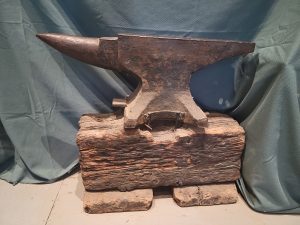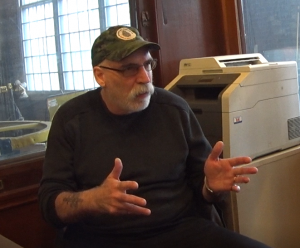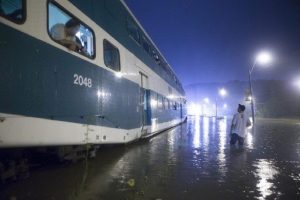Stuart Directs the Trains
Working for the railways is hard work. The days can be very long, and the work can be very tough:
I would work 16 hour days, 16 hour days, 16 hour days, three or four in a row and all I would be doing is coming home and sleeping and showering and then turning around and going back.
– Stuart Harvey, Train Movement Director, 2020
Stuart Harvey worked for Toronto Terminals Railway (TTR) from 1987 until 2014. The Toronto Terminals Railway is a subsidiary of Canadian National Railway and Canadian Pacific Railway. Stuart started working with TTR as a Building and Bridges Carpenter, and eventually became a Train Movement Director. In this later role, he was responsible for directing all rail traffic in the Union Station rail corridor in downtown Toronto.
If you have ever been on a train, you may wonder how they choose the tracks. You may think that the route is up to the engineer, but it is people like Stuart that do this work. Engineers control the speed of the train, but not the tracks and the route. It is the rail traffic controllers, like Stuart, that choose the tracks for the trains. What the work entails is coordinating all train movements by voice communication (radio) and with signal lights along the tracks. In downtown Toronto, rail traffic controllers work at several towers. An interesting fact for train movements through the John Street, Scott Street, and Cherry Street towers, is that rail traffic controllers operate vintage electro-mechanical signal systems built in the 1930s.
Rail traffic controllers manually manipulate levers to line switches, set signals and clear routes. To prevent their use during maintenance, tracks are blocked off (or protected) by physically placing “cans” over the levers.

This anvil (date unknown), which was on display at the museum when Stuart gave his interview in 2020, played an important role in the beginning of his railway career.
The area Stuart controlled was 5 kilometres. This may not seem like a big area to cover because other rail traffic controllers like Stuart are responsible to cover up to 800 km. The difference is that in downtown Toronto, the railway corridors are very dense and there are approximately 400 switches to cover. Outside of downtown Toronto, a rail traffic controller may cover more land, but they will have fewer switches. In 800 km, there may only be 4 switches.
Stuart pointed out that fellow employees can create a community:
It’s almost a fraternity, because you have to come together and because everybody, as I was talking about, [can make] mistakes, everybody who lasts in this business can come together. It’s very much a fraternity.
– Stuart Harvey, Train Movement Director, 2020
When Stuart lifted the anvil that is pictured above, this helped him join this brotherhood of railway workers. He earned their respect by demonstrating his strength.

Stuart Harvey during his interview.
Work on Christmas. Enjoy this audio clip with an English transcription.
During his interview, Stuart stressed the importance of family. He pointed out that while working on the railways is tough, spouses are also affected by their partner’s work. Like other challenging jobs, such as police officers or nurses, railway employees may be away from home for long periods.


